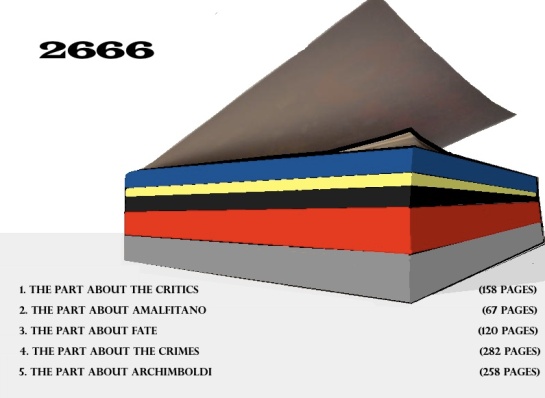[contains thoughts on Part IV but no major spoilers]
"Not reading, it might be said, was the highest expression of atheism or at least of atheism as he conceived of it. If you don't believe in God, how do you believe in a fucking book? he asked himself." --Bolano, 2666
From the opening sentence, 2666 announces itself as a book about the process of reading: "The first time that Jean-Claude Pelletier read Benno von Archimboldi was Christmas 1980, in Paris, when he was nineteen years old...". Part I, as I discussed in my last post, is almost entirely about reading, as the four Archimboldi critics create a new world of scholarship through their interpretations of Archimboldi. Also, although I'm struggling to locate good examples, Part I occasionally slips into a direct address to the reader: " 'Yes, of course,' said our four friends" (top of 106). That "our" incorporates the reader and calls attention to the artifice, something I haven't seen at all aside from Part I.
In Part II, the most fascinating book-centered issue is Amalfitano's mysterious geometry text (which he possesses with no memory of purchasing it). Naturally, he does what anyone would do with such a mystery text: he hangs it outside on a clothesline as an "experiment": "it's a Duchamp idea, leaving a geometry book hanging exposed to the elements to see if it learns something about real life." (195). Other reading-related issues of Part II concern letters from Amalfitano's wife, as well as a frustratingly long section where good old Amalfie reads passages from a tome about "Araucanian telepathy."
In Part III, Fate, a writer, heads to Mexico where he listens to an ex-prisoner give a five point lecture about "DANGER. MONEY. FOOD. STARS. USEFULNESS," the latter focusing specifically on the "usefulness" of a book called (amusingly) "An Abridged Digest of the Complete Works of Voltaire." Part II also contains my favorite fictional book title so far: Eating Ribs with Barry Seaman. Fate, like Amalfitano, also spends sections of Part III reading a book. In this case, it's The Slave Trade, which he was given (a gift from the last communist in Brooklyn!) prior to hearing Seaman's lecture The Communist hands him the book along with this advice "Son, I'm going to give you a book that will be of great use to you" (260).
Part IV, or as I call it, The Rape Section, contains the quote used above to open this blog post. There's also a reading devotee in this section, the young policeman Lalo Cura (though I'm not sure his constant reading of outdated crime manuals is going to help him solve these rapes and murders. I hope I'm wrong!). And of course there's the most notable (and, to me, infuriating) aspect of Part IV, the technical "crime-scene" / forensic documentation style of the murder victim sections. Is this meant to contrast wth a section in Part III, in which a "white-haired man" tells Fate about how 19th century writers wrote about death, in such a way "that you might get the idea that there was hardly any crime, or that a single murder could throw a whole country into tumult" (266). The man ends his reflection with these creepy and ambiguous lines about how the murders of society's outcasts were written about: "What happened to them could be written, you might say, it was legible. That said, words back then were mostly used in the art of avoidance, not of revelation. Maybe they revealed something, all the same way. I couldn't tell you" (267). There's no avoidance on Bolano's part in Part IV, however. He wants us to read about every rape and murder in Santa Teresa. So I will. But not without some grumbling.
And here's an illustration of the page lengths of each section from a funny little website called Bullshit English Homework .


Analytic graphics.....yes!
ReplyDelete"Merciful tedium of 2666."
ReplyDelete